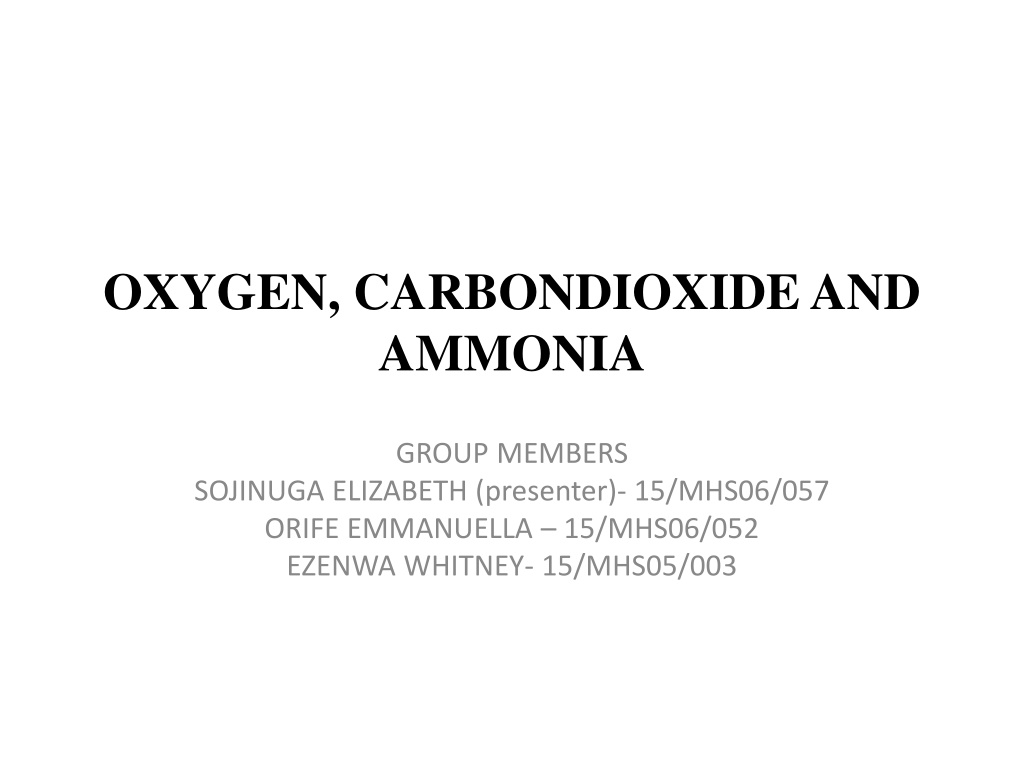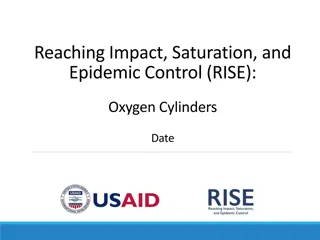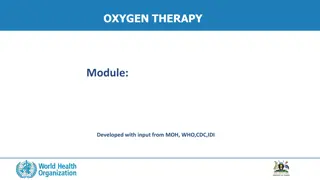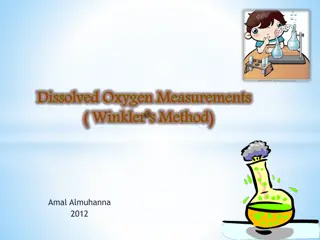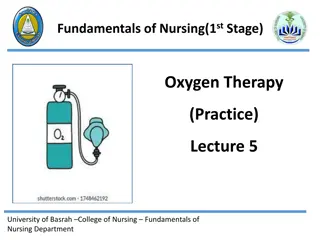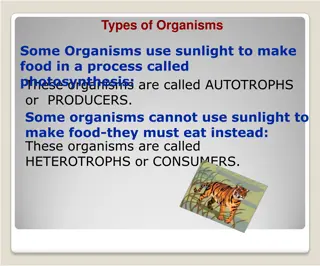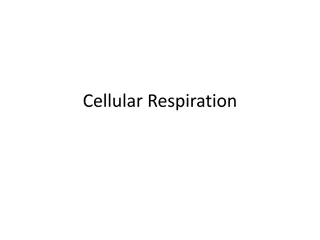Understanding Oxygen: Uses, Effects, and Importance in Living Organisms
Oxygen, a vital nonmetallic element, plays a crucial role in various processes essential for living organisms. It is involved in energy production, metabolism, immune system support, and more. However, the lack of oxygen can lead to serious conditions like hypoxia. Learn about the uses, effects, and significance of oxygen in this informative guide.
Download Presentation

Please find below an Image/Link to download the presentation.
The content on the website is provided AS IS for your information and personal use only. It may not be sold, licensed, or shared on other websites without obtaining consent from the author. Download presentation by click this link. If you encounter any issues during the download, it is possible that the publisher has removed the file from their server.
E N D
Presentation Transcript
OXYGEN, CARBONDIOXIDE AND AMMONIA GROUP MEMBERS SOJINUGA ELIZABETH (presenter)- 15/MHS06/057 ORIFE EMMANUELLA 15/MHS06/052 EZENWA WHITNEY- 15/MHS05/003
OXYGEN Oxygen (O) is a nonmetallic chemical element of Group 16, period 2, atomic number 8, of the periodic table. Two oxygen atoms join to form a single oxygen molecule, hence the term O2 (Joana et al., 2020). Oxygen is a colourless, odourless, tasteless gas essential to living organisms.
It is taken up by animals, which convert it to carbon dioxide; plants, in turn, utilize carbon dioxide as a source of carbon and return the oxygen to the atmosphere (Adam et al., 2018). Oxygen is carried around in the red blood cells by a molecule called haemoglobin.
In the human body, the oxygen is absorbed by the blood stream in the lungs, being then transported to the cells where an elaborated change process takes place. Oxygen plays a vital role in the breathing processes and in the metabolism of the living organisms (Roberts et al., 2000).
Uses of oxygen Oxygen is used in mitochondria to help generate adenosine triphosphate (ATP) during oxidative phosphorylation. One of the medical uses of oxygen is oxygen therapy It is used in hyperbaric medicine It is used in space and scuba diving suits (http://www.boundless.com/ , accessed February 2020).
Effects of oxygen Digest food Eliminate toxins from the body Fuel the body muscles Metabolize fat and carbohydrates Create energy Transport gases across cell membranes (Lian et al., 2009).
Strengthen the immune system Manufacture hormones and proteins Keeps the heart pumping and healthy Incites the lungs to breathe Allow the nerve system, and all other body tissues to function normally (Papiris et al, 2002).
HYPOXIA When the body does not have enough oxygen, this could result to hypoxemia or hypoxia. when the blood does not carry enough oxygen to the tissues to meet the body's needs, hypoxia is suspected (Lian et al., 2014).
Symptoms Changes in the color of skin, ranging from blue to cherry red Confusion Cough Fast heart rate Rapid breathing Shortness of breath Slow heart rate Sweating (Pascal et al., 2009).
Causes Lung diseases such as chronic obstructive pulmonary disease (COPD), emphysema, bronchitis, pneumonia, and pulmonary edema (fluid in the lungs) Strong pain medicines and other drugs that hold back breathing Heart problems Anemia (a low number of red blood cells, which carry oxygen) Cyanide poisoning (Cyanide is a chemical used to make plastics and other products) (Carol et al, 2018).
Estimation of oxygen This can be done using any of these method; An arterial blood gas (ABG) test is a blood test. It measures the blood s oxygen level. Pulse oximetry- pulse oxometer is a noninvasive device that estimates the amount of oxygen in the blood. It does so by sending infrared light into capillaries in the finger, toe, or earlobe. Then it measures how much light is reflected off the gases (Gendraf et al., 2001).
Oxygen level A normal blood oxygen level varies between 75 and 100 millimeters of mercury (mm Hg). A blood oxygen level below 60 mm Hg is considered low and may require oxygen supplementation.
Contd When blood oxygen level is too low compared to the average level of a healthy person, it can be a sign of a condition known as hypoxemia. This means that the body has difficulty delivering oxygen to all of its cells, tissues, and organs (Dauches et al., 2016). In most cases, high oxygen levels occur in people who use supplemental oxygen.
Treatment Treatment for low blood oxygen levels includes receiving supplemental oxygen. Some self-care measures can be taken by people to reduce symptoms of shortness of breath and improve general health and quality of life. These include: quitting smoking avoiding passive smoking in places where others smoke eating a healthful diet with plenty of fruits and vegetables exercising regularly (Frat et al, 2019).
CARBONDIOXIDE Carbon dioxide (chemical formula CO 2) is a colorless gas with a density about 60% higher than that of dry air. Carbon dioxide consists of a carbon atom covalently double bonded to two oxygen atoms (Eggleton et al., 2013).
In the human body, carbon dioxide is formed from the metabolism of carbohydrates, fats, and amino acids, in a process known as cellular respiration (Comellini et al., 2019). While cellular respiration is notable for being a source of ATP, it also generates the waste product, CO2. The body gets rid of excess CO2 by breathing it out
Uses of CO2 Carbon dioxide is used by the food industry, the oil industry, and the chemical industry (Peirantozzi et al., 2001). Precursor to chemicals Food additives and beverages Used for winemaking Used for stunning animals
Effects of CO2 Hyperventilation (rapid breathing) can cause too little CO2 and result in alkalosis (pH blood becomes elevated) (Chowdhuri and Badr, 2017). Hypercapnia, hypercarbia, or hypercapnea, is the physiological term for the condition of, and the body s response to, excessive carbon dioxide (Athayde et al., 2018). When CO2 levels become excessive, a condition known as acidosis occurs.
HYPERCAPNIA Hypercapnia is defined as the PaCO2 being greater than 42 mm Hg. If the PaCO2 is greater than 45 mm Hg, and the PaO2 is less than 60 mm Hg, a patient is in hypercapnic respiratory failure. This is usually due to hypoventilation or increased dead space in which the alveoli are ventilated but not perfused (Chowdhuri and Badr 2017). In a state of hypercapnia, there is an accumulation of CO2, which causes a drop in pH, leading to a state of respiratory acidosis.
Symptoms Suffocation by displacement of air Incapacitation and unconsciousness Headaches Vertigo and double vision Inability to concentrate Tinnitus Seizures (Comellini et al., 2019).
Causes Chronic obstructive pulmonary disease or COPD Sleep apnea (Baillieu, 2019). Genetics Nerve disorders and muscular problems Obesity (Athayde, 2018). Hypothermia
Estimation of CO2 Some tests used to diagnose hypercapnia include: Arterial blood gas test: This checks for blood levels of carbon dioxide and oxygen. Spirometer test: This test involves blowing into a tube to assess how much air a person can move out of their lungs, and how fast they can do this. X-ray or CT scan: These imaging tests can check for the presence of lung damage and lung conditions (Eggleton and Tony, 2013).
Carbondioxide level CO2 in its normal range from 38 to 42 mm Hg plays various roles in the human body. It regulates the pH of blood, stimulates breathing, and influences the affinity hemoglobin has for oxygen (O2) (Baillieu, 2019). Hypercapnia is defined as the PaCO2 being >42 mm Hg. If the PaCO2 is >45 mm Hg, and the PaO2 is <60 mm Hg, a patient is in hypercapnic respiratory failure.
CO2 level Contd When there is exposure to very high levels of CO2, in excess of 5% (50,000 ppm), the body s compensatory mechanisms can become overwhelmed, and the central nervous system (brain and spinal cord) functions are depressed, then fail. Death soon follows (Chowdhuri and Badr, 2017).
AMMONIA Ammonia (NH3), colourless, pungent gas composed of nitrogen and hydrogen. It is the simplest stable compound of these elements and serves as a starting material for the production of many commercially important nitrogen compounds (Steven et al.,2013). It is lighter than air, its density being 0.589 times that of air. In certain organisms, ammonia is produced from atmospheric nitrogen by enzymes called nitrogenases.
Ammonia (NH3) is produced as a byproduct of amino acid catabolism. Bacteria in the small intestines produce ammonia from glutamine, and urease-containing bacteria in the colon produce ammonia from breakdown of proteins and urea. Ammonia is taken up from portal blood by hepatocytes and converted to urea through the Krebs-Henseleit cycle (which is also less formally but more aptly known as the urea cycle ) (Hinkle et al., 2014).
Uses of NH3 Ammonia in Industries Agriculture Household Products For Manufacturing Various Compounds Metal Treating Petroleum
Effects of NH3 Ammonia is essential in the body as a building block for making proteins and other complex molecules. When ammonia enters the body as a result of breathing, swallowing or skin contact, it reacts with water to produce ammonium hydroxide. This chemical is very corrosive and damages cells in the body on contact.
Hyperammonemia Hyperammonemia is a metabolic condition characterized by elevated levels of ammonia in the blood. Increased entry of ammonia to the brain is a primary cause of neurologic disorders, such as congenital deficiencies of urea cycle enzymes, hepatic encephalopathies, Reye syndrome, several other metabolic disorders, and some toxic encephalopathies (Pegg and Zaman, 2014).
Contd Hepatic encephalopathy, a condition that happens when the liver is too diseased or damaged to properly process ammonia. In this disorder, ammonia builds up in the blood and travels to the brain. It can cause confusion, disorientation, coma, and even death (Pegg et al., 2014).
Contd Reye syndrome, a serious and sometimes fatal condition that causes damage to the liver and brain. It mostly affects children and teenagers who are recovering from viral infections such as chicken pox or the flu and have taken aspirin to treat their illnesses. The cause of Reye syndrome is unknown. But because of the risk, children and teens should not take aspirin unless specifically recommended by your health care provider.
Contd Urea cycle disorders, rare genetic defects that affect the body's ability to change ammonia into urea. The test may also be used to monitor the effectiveness of treatment for liver disease or kidney failure (Hinkle et al., 2014).
Symptoms Confusion Fatigue Loss of appetite Nausea with or without vomiting Pain in the back, sides or abdomen Weakness (loss of strength)
Causes Alcohol abuse Certain medications such as diuretics and narcotics Drug abuse Gastrointestinal bleeding Heart failure Hepatic encephalopathy (damage to the brain due to liver failure) Kidney disease Liver disease or damage, such as cirrhosis or severe hepatitis (Jalan, 2003).
Ammonia level The normal range for Adult: 10-80 mcg/dL or 6-47 mol/L (SI units) An elevated ammonia level in blood (100 mol/L or higher) is an indicator of an abnormality in nitrogen homeostasis(Pediatr, 2001).
Selected Reference Athayde R.A.B., Oliveira J.R.B., Lorenzi F.G. and Genta P.R. (2018). Obesity hypoventilation syndrome: a current review. J Bras Pneumol. 44(6):510-518. Baillieul S., Revol B., Jullian-Desayes I., Joyeux-Faure M., Tamisier R. and P pin J.L. (2019). Diagnosis and management of central sleep apnea syndrome. Expert Rev Respir Med. 13(6):545-557. Chowdhuri S. and Badr M.S. (2017). Control of ventilation in health and disease. CHEST. 151(4), 917 929. Comellini V., Pacilli A.M.G. and Nava S. (2019). Benefits of non- invasive ventilation in acute hypercapnic respiratory failure. Respirology. 24(4):308-317 Eggleton and Tony (2013). A Short Introduction to Climate Change. Cambridge University Press. p. 52. ISBN 9781107618763.
Frat J.P., Coudroy R. and Thille A.W. (2019). Non-invasive ventilation or high-flow oxygen therapy: When to choose one over the other? Respirology. 24(8):724-731. Hinkle J., Cheever K., Brunner and Suddarth. (2014). Handbook of Laboratory and Diagnostic Tests. 2nd Ed, Kindle. Philadelphia: Wolters Kluwer Health, Lippincott Williams and Wilkins. Ammonia, Plasma; pg. 40. Jalan R. (2003). Intracranial Hypertension in Acute Liver Failure: Pathophysiological Basis of Rational Management. Semin Liver Dis.;23(3):271-282. Pegg E.J. and Zaman F. (2014). Sodium valproate-related hyperammonaemic encephalopathy. Case Reports. (Feb 21):bcr2014203899-bcr2014203899. doi:10.1136/bcr-2014-203899.
